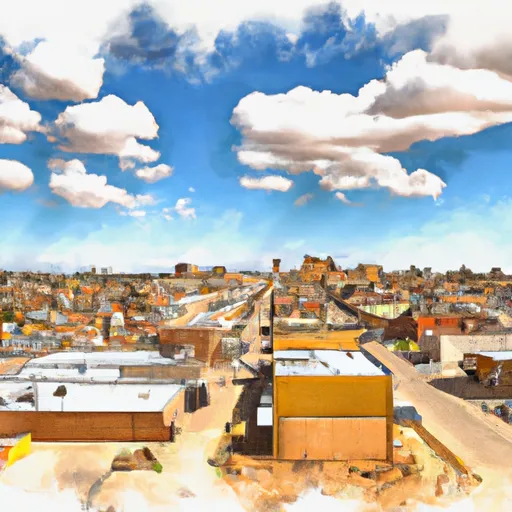-
 Snoflo Premium
Snoflo Premium
Get unlimited access to all our content
With no Ad interruptions! - Start Your Free Trial Login with existing account
Winslow
Eden Index
Climate
8.7
•
Recreation
•
Community
•
Safeguard
3.5/10

Winslow, Arizona is a small city located in Navajo County, in the northeastern part of the state. Known for its rich history and stunning landscapes, Winslow experiences a semi-arid climate characterized by hot summers and mild winters. Summers can be scorching, with temperatures often exceeding 100°F, while winters are mild, with daytime temperatures ranging from the 50s to 60s°F.
The hydrology constituents in Winslow mainly revolve around the Little Colorado River, which flows through the city. The river provides opportunities for water-based activities such as fishing, boating, and kayaking. It also contributes to the lush vegetation and wildlife diversity in the area.
Winslow offers numerous outdoor recreation opportunities. The nearby Homolovi State Park showcases ancient Ancestral Puebloan ruins, making it a popular destination for hiking and exploring archaeological sites. The Petrified Forest National Park, just east of Winslow, is renowned for its stunning petrified wood and unique geological formations, attracting hikers and nature enthusiasts. Additionally, the city is situated on the iconic Route 66, offering visitors a chance to experience the nostalgia and history of this iconic highway. Overall, Winslow provides an exceptional blend of outdoor activities, cultural heritage, and natural beauty.
What is the Eden Index?
The Snoflo Eden Index serves as a comprehensive rating system for regions, evaluating their desirability through a holistic assessment of climate health, outdoor recreation opportunities, and natural disaster risk, acknowledging the profound impact of these factors on livability and well-being.
Climate Health Indicator (CHI): 8.7
Winslow receives approximately
212mm of rain per year,
with humidity levels near 52%
and air temperatures averaging around
13°C.
Winslow has a plant hardyness factor of
7, meaning
plants and agriculture in this region tend to thrive during the non-winter months.
By considering the ideal temperature range, reliable water supplies, clean air, and stable seasonal rain or snowpacks, the Climate Health Indicator (CHI) underscores the significance of a healthy climate as the foundation for quality living.
A healthy climate is paramount for ensuring a high quality of life and livability in a region, fostering both physical well-being and environmental harmony. This can be characterized by ideal temperatures, reliable access to water supplies, clean air, and consistent seasonal rain or snowpacks.
Weather Forecast
Streamflow Conditions
Little Colorado
Area Rivers
Little Colorado
Snowpack Depths
Little Colorado
Reservoir Storage Capacity
Little Colorado
Groundwater Levels
Recreational Opportunity Index (ROI):
The Recreational Opportunity Index (ROI) recognizes the value of outdoor recreational options, such as parks, hiking trails, camping sites, and fishing spots, while acknowledging that climate plays a pivotal role in ensuring the comfort and consistency of these experiences.
Access to outdoor recreational opportunities, encompassing activities such as parks, hiking, camping, and fishing, is crucial for overall well-being, and the climate plays a pivotal role in enabling and enhancing these experiences, ensuring that individuals can engage in nature-based activities comfortably and consistently.
Camping Areas
| Campground | Campsites | Reservations | Toilets | Showers | Elevation |
|---|---|---|---|---|---|
| McHood | 11 | 4,885 ft | |||
| Homolovi Ruins State Park | 53 | 4,942 ft |
Nearby Ski Areas
Catastrophe Safeguard Index (CSI):
The Catastrophe Safeguard Index (CSI) recognizes that natural disaster risk, encompassing floods, fires, hurricanes, and tornadoes, can drastically affect safety and the overall appeal of an area.
The level of natural disaster risk in a region significantly affects safety and the overall livability, with climate change amplifying these risks by potentially increasing the frequency and intensity of events like floods, fires, hurricanes, and tornadoes, thereby posing substantial challenges to community resilience and well-being.
Community Resilience Indicator (CRI):
The Community Resilience Indicator (CRI) recognizes that education, healthcare, and socioeconomics are crucial to the well-being of a region. The CRI acknowledges the profound impact of these elements on residents' overall quality of life. By evaluating educational resources, healthcare accessibility, and economic inclusivity, the index captures the essential aspects that contribute to a thriving community, fostering resident satisfaction, equity, and social cohesion.

